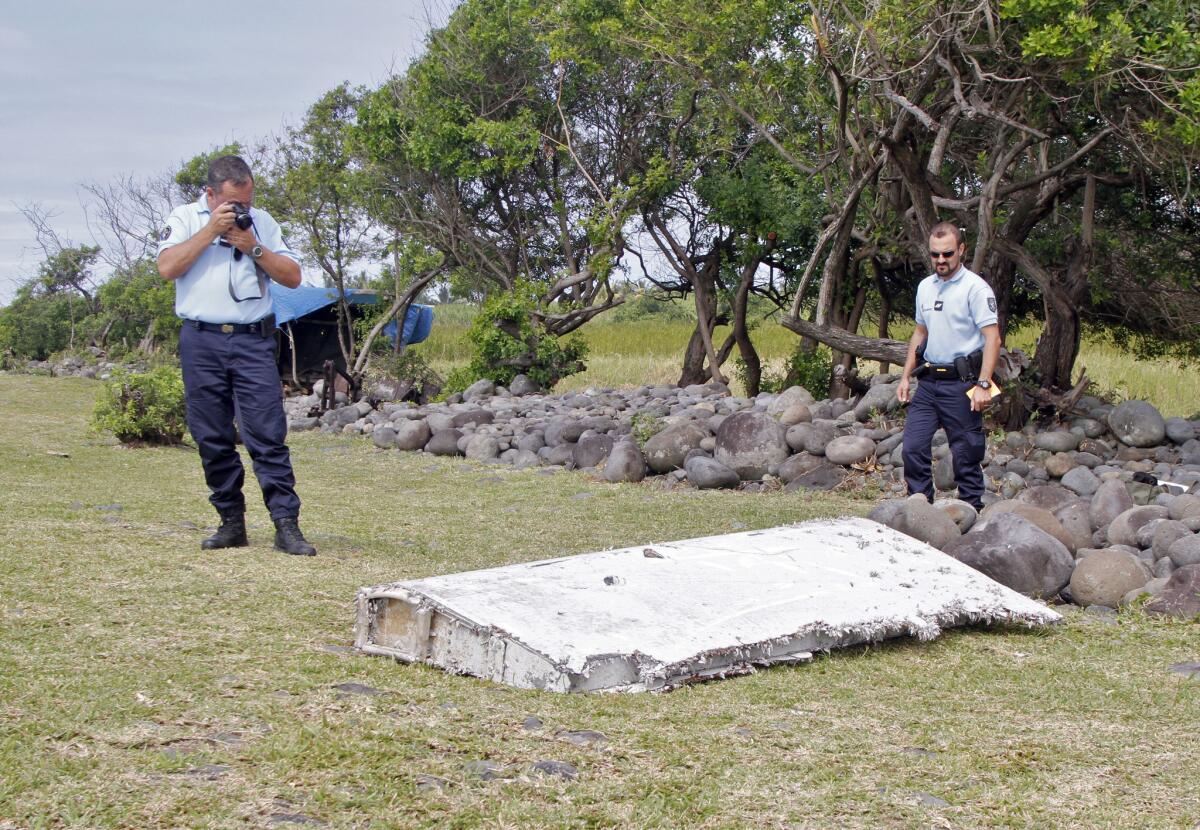What a six-foot chunk of plane debris might bring to the MH370 mystery

French police officers made an initial examination and documentation of a wing piece found on the Indian Ocean island of Reunion on Wednesday. It appeared to be the first hard evidence that missing Malaysia Airlines Flight 370 crashed more than 16 months ago.
- Share via
A six-foot piece of a Boeing 777’s wing assembly discovered on a remote Indian Ocean island is expected to provide the first hard evidence that Malaysia Airlines Flight 370 crashed 16 months ago and could help investigators narrow the search for the wreckage, experts said Friday.
Aviation forensic experts at a defense laboratory in France have yet to confirm that the barnacle-encrusted “flaperon” pulled out of shallow waters by beachcombers on the French territory of Reunion Island came from the doomed flight that went missing on March 8, 2014.
But close-up pictures of the wing piece bearing an identifying maintenance number and showing tell-tale damage to the flaperon’s edge suggest that it broke off the aircraft during a high-speed dive after running out of fuel, a prominent aviation accident analyst said Friday.
That validates one of the main theories about what happened to the plane -- that it plummeted into the ocean in a deep, high-speed dive rather than gliding into a lower-impact crash into the water’s surface, said David Soucie, a former accident investigator for the Federal Aviation Administration and author of “Why Planes Crash” and a recently published book on the MH370 mystery.
“They can use this flaperon to validate certain assumptions, one assumption being that when the aircraft ran out of fuel it made an almost straight spiral down,” said Soucie. “That creates incredible turbulence, so much that it could cause fluttering, as evidenced by the back of the flaperon that is so torn up, while the front has very little damage.”
The ragged edge of the flaperon found on Reunion Island on Wednesday was likely caused by the mach-speed flow of air over the wing as the aircraft plummeted into the ocean, Soucie said.
A 46,000-square-mile search area has been defined by the Australian authorities leading the investigation into the MH370 disappearance, based on analysis of the last known location of the plane long presumed to have carried all 239 on board to their deaths.
Radar tracking of the Boeing 777 showed that it departed from its intended course from Kuala Lumpur to Beijing about an hour into the flight and after the plane’s transponders had been disabled. The plane continued to receive and return satellite signals as it flew south over the ocean, leaving a trail of electronic “handshakes,” the seventh and last of which was a starting point for defining the search field.
If investigators conclude from examination of the flaperon that the plane crashed in a swift dive, rather than gliding as much as 20 miles after running out of fuel, that would shorten the projected search area by about 8 miles in each direction, Soucie said.
Photos of the flaperon also make clear that its mountings behind the aircraft’s right wing are missing, a further indication that the flap used to bank the aircraft during turns and landings broke off from the intense vibration of the high-speed plunge, he said.
“The question was did it come off when it hit the water or broke off in the air,” Soucie said. Noting the relatively intact forward part of the flaperon, he said there “would have been other evidence of damage if it hit the water first.”
Not all aviation safety experts are drawing the same conclusions, however. William Waldock, a professor of aviation safety and rescue at Embry-Riddle Aeronautical University in Prescott, Ariz., told the Associated Press that the relatively intact flaperon “argues that it wasn’t a very violent impact, which goes along with some of the theories that it just ran out of gas and glided down.”
Oceanographers also may be able to glean important new information about the path the flaperon traveled after detaching from the aircraft.
Barnacles are visible along the edges of the flaperon, and marine scientists will examine them to determine how long the wing piece was in the water and whether other bits of sea life might indicate where it has been for the past 500 days, said Australian Deputy Prime Minister Warren Truss, who is in charge of the ongoing search for the plane’s wreckage.
“I believe that we are approaching the resolution of the mystery of MH370,” Malaysia’s deputy transport minister, Abdul Aziz Kaprawi, told the Agence-France Presse news agency in reporting that the wing piece en route to the French laboratory in Toulouse was almost certainly from the missing aircraft.
Soucie, asked what he thought were the chances of the plane wreckage eventually being located, responded: “100%.” But he conceded that it remained difficult to predict a time frame.
Unless the missing plane’s black boxes are recovered, investigators will be deprived of vital pieces of information to determine what happened to the missing aircraft and those on board. The cockpit voice recorder would likely clarify whether the pilots were incapacitated, what prompted the disabling of the transponders that facilitate radar tracking of flights and whether the passengers were conscious and aware of whatever distress precipitated the plane’s destruction.
Follow @cjwilliamslat for the latest international news 24/7
MORE ON MH370:
Malaysia Airlines Flight 370’s fate is an ongoing mystery
MH370: A year of waiting, wondering and heartache for families
Searchers looking for MH370 find shipwreck, expand zone of activity
More to Read
Sign up for Essential California
The most important California stories and recommendations in your inbox every morning.
You may occasionally receive promotional content from the Los Angeles Times.











